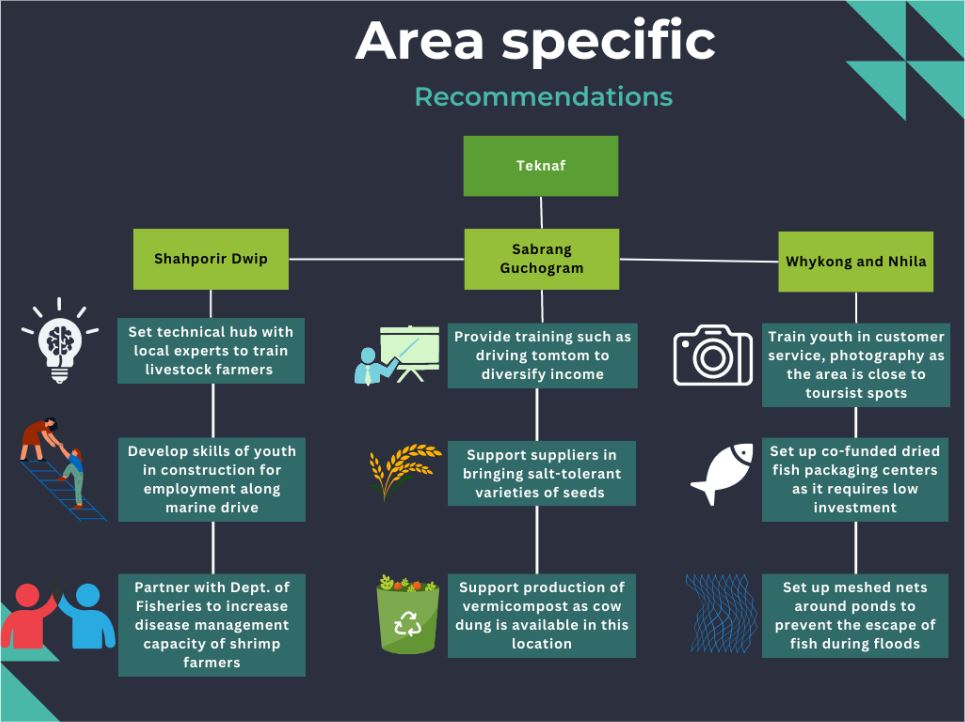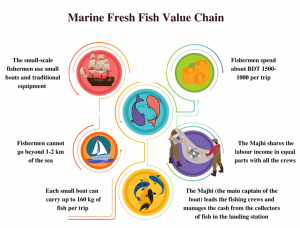This study assessed six value chain including Fresh and Dried Fish value chain, Agriculture, Small Business (hair dressing, retail stores), Tomtom (e-bikes), Salt and Poultry/Dairy to identify opportunities for enhancing current income or creating alternative livelihood options given the current circumstances in Teknaf. A summary of the key outputs from this study is given below.
A significant majority of the population of Teknaf is engaged as Fisherfolk and Salt Farmers. The artisanal fishermen work as labourer for the boat owners, as they do not have their own boat and fishing net. This relationship between the boat owner and artisanal fishermen, significantly undermines the earning potential of the artisanal fishermen. The fishing crew led by the captain of the boat (Majhi) exerts the effort and risk of catching fish in the sea, but they only capture approximately 10% of the total value of fish. Moreover, fishing is a seasonal activity, the fishermen cannot go fishing for six months in a year. There is a 65-day ban from May to July and then again for 22 days from October to November. The window of time for the 65-day ban is the ideal time for fishing for the artisanal fisherfolk, it is the time when the sea is hospitable for fishing and there is a possibility of abundant catch. Immediately after the ban expires, is the time when the fish migrates to rivers and the sea starts to become turbulent. The constriction of the fishing period combined with the less availability of catch has significantly impacted the livelihood of the fisherfolks. The 65-day ban has also impacted the dried fish value chain as the dried processors volume and profitability of business depends on the availability and price of fresh fish.
Moreover, the nature of the informal debts (Dadon) to fisherfolks entrapped the low income fisherfolks in a cycle of debts and poverty, as the terms of Dadon significantly depresses the value creation from business. Moreover, the fishing ban in Naf river as an anti-drug trafficking measure had also restricted the source of income of the residents of Teknaf.


Lastly, pond aquaculture is rising in Teknaf, mainly driven by the consumer demand of the non-local population including NGO workers, volunteers, and private sector representatives. Currently, there are only 729 ponds in Teknaf, and the lease condition are relatively expensive compared to enclosures. But due to the high price of white fish in Teknaf, the low-income fish farmers are encouraged to start pond aquaculture.
The salt farming is also a common profession among the targeted community. The labourers of the salt beds are also termed salt farmers. The owners of salt beds are generally from a solvent economic background, as the development of salt beds is labour intensive. Each bed of salt produces approximately 400-480 kg of salt per cycle (each cycle last about 3-5 days) and a 40 decibel of land has about 5 beds. Despite the large volume of salt production, the salt farmers make a small profit, mainly because they must sell the salt at BDT 150-200 per kg during the dry season. The large-scale import of salt and the high bargaining power of the industrial salt processors deprives the salt farmers of a fair price.
During the wet season, most of the salt farmers and shrimp farmers engage in cultivating rice. In most parts of Nhila and Whykong, rice cultivation is the only crop that is cultivated. The salinity in the water and high precipitation during the monsoon is unsuitable for other vegetables and crops. Rice cultivation is subsistence in nature and in general, selling rice in the market is not profitable. In some elevated landscape in Shahporir Dwip, Teknaf Sadar, Nhila and Whykong cultivation of different vegetables takes place. However, a large portion of the local consumer demand for vegetables in Teknaf comes different regions, particularly Chittagong. The irregular precipitation pattern and the flooding during the monsoon are the major challenges in the agriculture sector in Teknaf.
The small-scale service sector such as Tailoring, and Hairdressing have steadily grown in the area. The women in the households have received training from different NGOs on tailoring, it has increased the number of home-based tailors. But most of these tailors do not have the business skills and adeptness in variety of designing to attract customers. The shop-based tailors are relatively more professional and gets better access to captive customer base from school parents for uniforms and stitching clothes for festivals. Similarly, hairdresser with physical salon has stronger volume of business.

